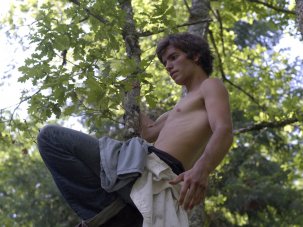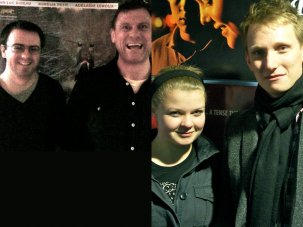Web exclusive

The Scouting Book for Boys
I made my way to meet Nick James at our rendezvous in St Pancras with a mixture of emotions. The first was, “Oh my, I’m actually going to meet the editor of Sight & Sound.” The second was nervousness about what he might think of me. I didn’t know what to expect as the only picture I’d seen of him was in the opening pages of the magazine. Fortunately he made me feel welcome, though it took me a while to feel at ease. He gave me some guidance and suggested some techniques to prevent me faltering whilst conducting my interview.
Amongst his tips, Nick told me to do my research on the director and the film, which of course I had prior to my journey to London; to use a prompt-list to help trigger ideas for questions, and to ask the director about particular scenes or shots. He also said I should not immediately enlighten the director by saying how brilliant I might have found his film, but to keep him on edge until I’d finished interviewing him, when I’d be free to say how much I enjoyed his film. (Which, as it turned out, I did profusely.)
Following this I went to the Ritzy Picturehouse in Brixton to watch The Scouting Book for Boys, the first feature by 29-year-old Tom Harper. I was glad he was young, because I felt I’d be able to relate to him more than I would had he been in his fifties. That said, Ken Loach is in his seventies but I wouldn’t complain if I had the opportunity to interview him.
The film is about the relationship between David (Thomas Turgoose) and Emily (Holly Grainger), teenagers who live on a caravan park in Norfolk, and the journey that they both face – although the audience views the journey through David’s perspective. The first couple of scenes show the pair getting up to mischief, jumping to and from caravans, as well as stealing from the local shop. They are portrayed as still innocents, here, which is significant given subsequent events, and very realistically done.
Emily finds out that she is being sent to live with her father. This puts an emotional strain on David and Emily’s friendship. Not long afterwards Emily goes missing, leaving David to deal with the police investigation and constant questioning from both Emily’s parents and Steve, a worker at the caravan park. In fact, Emily has gone into hiding in a cave, and Steve plays a significant part in the reasons why. When she decides she wants to come out again, David is moved to take drastic measures.
I had half an hour to prepare my questions before I interviewed Tom and because he had already done a question-and-answer in the cinema, I was nervous and worried that he would find my interview tedious. Despite this he was very friendly, patient and elaborate with his answers, and within five minutes the interview was flowing smoothly. The first thing he said to me was “So do you know Tomo?” – ‘Tomo’ being Thomas Turgoose’s nickname – because both Thomas and I are from Grimsby. Unfortunately I don’t know him, but not long after I’d gotten home from London I saw him outside of Barclays Bank and I felt somewhat amazed.
How did you get involved in ‘The Scouting Book for Boys?’
I had wanted to work with Jack Thorne, the writer, for quite a long time. We did the Channel 4 scheme ‘Coming Up’, a series of eight short films, together. I loved Jack’s script on a short film called ‘The Spastic King’ and I wanted to direct it but for a variety of reasons I didn’t. From that point I knew that I really liked his writing. I got in contact with Jack and the producer (Celador Films) sent me his script; we all got together and they asked me to come on board and I said I’d love to.
You’ve worked in television, directing a couple of episodes of ‘Demons’. Is there a transition between working in television and working in film?
Yes, most definitely. The Scouting Book for Boys is very different from Demons, which is aimed at a very mainstream ITV audience. The Scouting Book for Boys is a much more personal story about one boy’s journey through a period in his life.
What did you find most interesting about the script?
There was this central character, David, who I really cared for and who took actions that I disagreed with and I think that in film you tend to have a central character who is the hero and the audience has to believe in and buy into everything they do, and that’s not real life. In real life people make mistakes and it’s interesting to follow a character who doesn’t always make the right decisions because that’s more realistic.
There was a high usage of close-ups throughout the film. Could you talk to me about that and why were they used?
A lot of the film is from the main character’s point of view, and because his facial expressions are so small, I wanted the camerawork to focus on his observations of what he does. He manages to get away from this increasingly tense situation of the police investigation. That’s why I wanted to get particularly close on David, because if you watch closely enough you can see the subtleties of what’s going on beneath the surface.
Who are your influences?
Alfred Hitchcock, the Coen Brothers, John Landis, Gus Van Sant. The wonderful thing about film is that it’s constantly changing, taste changes and your influence changes. Film is constantly evolving.
What do you plan to do in the future? Do you have any other films planned?
I’ve got another film called Cheerleaders. It’s set in the London Borough of Hackney and it’s about a group of girls who are the opposite of the American dream. They drink, smoke, get into fights and into all sorts of mischief. It’s a coming-of-age story but also a more commercial film. It’s a fairly classic Hollywood structure, what I really want to bring to it is a little honesty and reality.
-
The Digital Edition and Archive quick link
Log in here to your digital edition and archive subscription, take a look at the packages on offer and buy a subscription.






